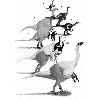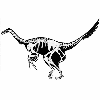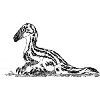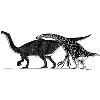THERIZINOSAURIA
CLASSIFICATION
Animalia: Vertebrata: Tetrapoda: Sauropsida: Archosauromorpha:
Ornithodira: Dinosauria: Theropoda: Tetanurae: Coelurosauria
CLADOGRAM:
—Therizinosauria sensu D. A. Russell, 1997 emended herein “Therizinosaurus‘ taxon” == {Therizinosaurus > Oviraptor, Ornithomimus, Troodon} =Segnosauria =Segnosaurischia
| INCERTAE SEDIS:
| unnamed form — Aptian to Albian — Utah
| ?cf. Erlikosaurus (frontal) — middle-late Campanian — Alberta
| unnamed form (partial skeleton including forelimbs) — Late Cretaceous — Mongolia
| “Neimenggusaurus”
| “Chilantaisaurus” zheziangensis
|?-Beipiaosaurus
`–Therizinosauroidea [implied in Maleev, 1954] sensu D. A. Russell & Dong, 1995 == {Therizinosaurus + Alxasaurus} =Segnosauroidea
|–Alxasauridae D. A. Russell & Dong, 1995 == {Alxasaurus > Therizinosaurus}
| `–Alxasaurus
`–Therizinosauridae Maleev, 1954 non Sereno, 1999 == {Therizinosaurus > Alxasaurus} =Segnosauridae
| INCERTAE SEDIS:
| ?“Nanshiungosaurus” bohlini
|–Nothronychus
`–Therizinosaurinae
|–Enigmosaurus
|–Erlikosaurus
|–Nanshiungosaurus
|–Segnosaurus
`–Therizinosaurus
ESSAY
| A PUZZLER:These Asian dinosaurs pose some taxonomic problems. They were originally classified as theropods, although they have some features very uncharacteristic for theropods. Their hips are bird-like, although some theropods such as the dromaeosaurids and birds themselves have bird-like hips as well. The front of the snout is a toothless beak, although oviraptorids, ornithomimids, and several avian lineages have toothless beaks as well. But the feet, which have four functional, forward-facing toes, are utterly unlike any other theropod feet. Except for some modern birds, all theropods have three functional toes and a reduced dewclaw. C OMPETING VIEWPOINTS:Another theory was that they were an outgroup to the ornithischians, since ornithischians have bird-like hips (although they are only superficially bird-like), beaks, and, in the most primitive ornithischians, four toes. It has also been proposed that they are late-surviving relatives of “prosauropods“, since their teeth and feet are similar to those of “prosauropods”. (They are similar enough that one jawbone from the Early Jurassic of China was published as the earliest therizinosaur, although it is more likely a “prosauropod”.) A C ONSENSUS (S ORT OF):The discovery of Alxasaurus, a therizinosaur more primitive than those previously known, seemed to bolster the theropod theory, as it had some coelurosaurian features. More recently, the discovery of an even more primitive therizinosaur, Beipiaosaurus, solidifies the therizinosaurs’ status as theropods, since it has a dewclaw. Interestingly, it also has impressions of feathers or feather-like integument. There is still disagreement over which coelurosaurian group therizinosaurs are related to. They have been allied with deinonychosaurs, ornithomimosaurs, and oviraptorosaurs. Beipiaosaurus has oviraptorosaur-like features in its pelvis. |
IMAGES

| Field Guide to the TherizinosauriaI. Beipiaosaurus inexpectus II. Enigmosaurus mongoliensis III. “Chilantaisaurus” zheziangensis (based on other Therizinosauria) IV. Alxasaurus elesitaiensis V. Erlikosaurus andrewsi VI. Segnosaurus galbinensis VII. Nanshiungosaurus brevispinus (based on other Therizinosauria) VIII. “Nanshiungosaurus” bohlini (based on other Therizinosauria) IX. Therizinosaurus cheloniformis |

skeletal diagram of a generic therizinosaurid: Enigmosaurus: ilium (partly), pubis, ischium; Erlikosaurus: skull (partly), pes; Nanshiungosaurus: ilium (partly), cervical & dorsal vertebrae; Segnosaurus: mandible, scapulocoracoid (partly), ilium (partly), hindlimb, first pedal ungual; Therizinosaurus: forelimb, scapulocoracoid (partly); all else speculative |

